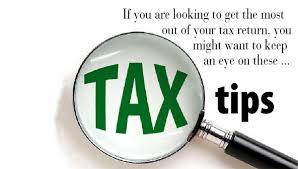The Tax Cuts and Jobs Act of 2017 amended the Internal Revenue Code of 1986, also referenced as the U.S. tax code. This major tax legislation has made several significant changes and may have taxpayers a little uneasy. Understanding its impact on individuals, businesses, tax exempt and government entities can be daunting and requires the attention of a professional tax preparer – a Certified Public Accountant (CPA) or an Enrolled Agent (EA).
Here are tips on how you can make the most of the tax deductions.
How should one handle end-of-year bonuses and financial incentives from their job?
Depending upon the taxpayer’s income tax bracket, deferring year-end bonuses and other financial incentives may prove beneficial to minimize the tax liability for the current year.
If deferring year-end bonuses and other incentives is not an option, the tax payer should have the maximum amount of taxes withheld from the year-end bonuses and other incentives. Also, if the tax payer has not taken advantage of the maximum contribution limit for participation in 401(k), 403(b), and most 457 plans, this would be a great opportunity to catch up on those deferrals and defer the related compensation. The maximum contribution limit for 2018 is $18,500.
Should one defer them to the following year?
If possible, yes.
Can depreciable assets like a computer, iPad, tablet and home appliances help offset tax burden?
Depreciable assets like a computer, iPad, tablet and other appliances may only be deductible if the taxpayer has a business in which those items are utilized. However, the sales tax that are paid for such items are deductible on the Schedule A if the tax payer utilizes the long form. But remember, the maximum state and local tax deduction that can be taken in 2018 is $10,000. This $10,000 limitation includes all state and local taxes, including property taxes and sales taxes.
What are some other business purchases that will help?
Major purchases, including vehicles, appliances and furniture may help a tax payers’ tax position if the tax payer files a long form and utilizes the Schedule A. But remember, the maximum state and local tax deduction that can be taken in 2018 is $10,000. This $10,000 limitation includes all state and local taxes, including property taxes and sales taxes.
What type of questions should one ask a tax preparer to determine if they are a good fit?
Are you a Certified Public Accountant or Enrolled Agent? How long have you been in practice? How much of your clientele includes the preparation of the long tax form? What is your philosophy regarding income tax preparation? How many of your clients have been audited in the past six years? What type of audit defense services do you offer in the event a tax return that is prepared by you gets audited?
What should a client typically bring to an appointment with their tax preparer?
A client should always bring at least the prior two years’ tax returns with them to any meeting with the tax preparer. The tax preparer should also include a check list of items that should be brought to that meeting. Please see the check list that I provided to you as an example of what I give to my clients.
What is the maximum investment into a retirement account that will be beneficial?
The tax payer should always max out on the contribution limit allowed into 401(k), 403(b) and most 457 plans. For 2018, this amount is $18,500. There is a take home pay calculator the tax payer can utilize to conduct an analysis on the difference in their take home pay when maximizing the retirement contributions.
Is there a maximum charitable, standard donation benefit or does it vary according to your income?
For 2018, a tax payer can deduct a maximum of 60% of their adjusted gross income for qualified chartable contributions. This is an incredible tax advantage that less than 10% of tax payers take advantage. Also, statistics show that less than 20% of tax payers contribute to local charities, churches and not-for-profits.
Is there a best practice formula for claiming tax withholdings and exemptions?
There is not necessarily a best practice for claiming tax withholdings and exemptions, but I always prefer to have my clients owe the government rather than receive a refund.




